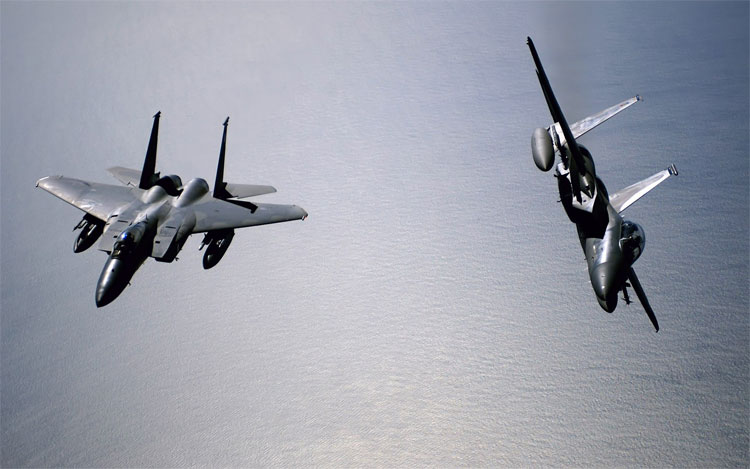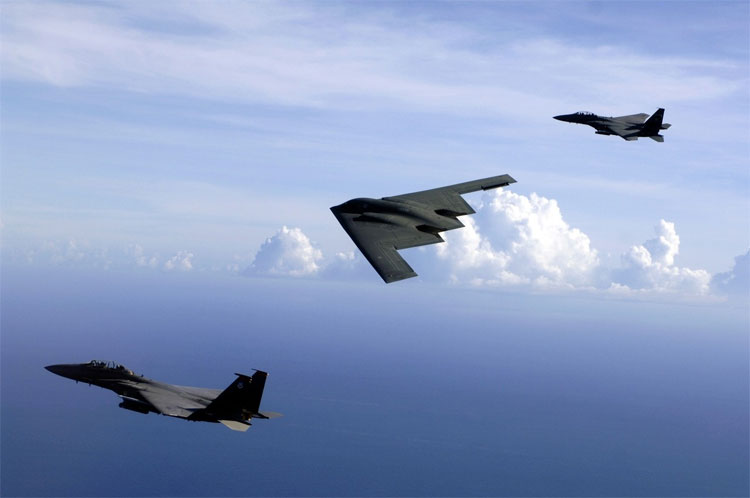Why do fighters often fly?
In the process of training, fighting and doing aerial missions, fighters often move in formation, very closely and precisely in which often see the formation of 2 aircraft.
Flying formation is a form of moving according to a predetermined position, keeping a strict distance and operating at the request of the commander. In the military, fighter pilots use their own squad to protect each other and enhance firepower when attacking targets.
In civilian, aircraft use formations when participating in exhibitions or celebrations. In addition, the movement of the formation also helps the aircraft to optimize the dynamics, reduce the drag of the air, and save fuel.

The fighters paired in the sky.
Double flying
The formation strategy was born in World War I, when the fighters were tasked to escort spy planes when operating in enemy airspace. After that, the full-force squad quickly appeared because this helped them to strengthen their defenses as well as attack.
In 1918, the smallest flying squadron began to form with two fighters. The German pilots, then Oswald Boelcke, Max Immelmann and Manfred von Richthofen were the first performers and made strict rules when flying in formation.

2 fighters supporting bombers.
According to many aviation websites, when traveling with a lineup of two aircraft, fighters were divided into command and support. At that time, the aircraft supported the task of shielding the vulnerable corners for commanding aircraft, helping the aircraft focus only on attacking the target without being struck up.
However, in the present era, the fighting squad is usually more than 2 fighters. The main task of the pair of fighters is now to escort strange planes out of national airspace or to fly to protect special targets.
This is to ensure that targets that are escorted or protected cannot escape the control of the fighters.
Variant
Starting from flying couples, during the period between World War I and World War II, the pilots began to create new flying squads with the participation of more than two fighters. From here, they give different shapes, positions and distances for each task.
In bad weather, operating near the airport or simply flying, they will fly at close range. However, when performing missions in enemy airspace or missions that have the ability to bend, change direction suddenly, increase the risk of collisions, the fighters will adjust the formation.

3-flight squad.
While flying close range, fighters can be only a few meters apart, in the battle line, this distance can be up to hundreds of meters.
When flying in battle formations, the navigation, communication and tactical decisions are given by commanders, often the most experienced of the squadron. Support pilots have the duty to follow the direction of the commander and maintain a certain distance with the leading aircraft.
Because flying near close range aircraft is dangerous, both military and civilian, disciplined, experienced, predictable and rules are maintained. The announcements are brief for pilots to listen, analyze and coordinate smoothly. Therefore, no one outside the commander is allowed to issue voice commands via radio.
- He built a 'variation' fighter and repaired himself
- How much oil does the fighter burn in 1 hour?
- Japan buys a new fighter jet
- The United States will build fighters that are 2.5 times faster than flying bullets
- The UAV model promises to change the military nature of the US military
- The ability to shoot down planes of fighters Ukraine
- Learn the dominant power of Su-35 fighter
- Uncrypted secret of the Great Lake region
- Experiment with the model of extinguishing storms by fighter
- Battle record of Su-22 aircraft
- 'Green heroes'
- Birds sneak through narrow slots like fighters
 'Fine laughs' - Scary and painful torture in ancient times
'Fine laughs' - Scary and painful torture in ancient times The sequence of numbers 142857 of the Egyptian pyramids is known as the strangest number in the world - Why?
The sequence of numbers 142857 of the Egyptian pyramids is known as the strangest number in the world - Why? History of the iron
History of the iron What is alum?
What is alum?